Lean Manufacturing Implementation to Enhance Automotive Productivity
VerifiedAdded on 2022/11/24
|15
|3765
|88
Report
AI Summary
This report investigates the application of lean manufacturing principles to improve productivity within the automotive industry. It begins by defining lean manufacturing and its core concepts, emphasizing waste identification and elimination through continuous improvement. The report then delves into the implementation of various lean strategies, including functional expertise and stability, supplier-customer relationships, continuous improvements, socialization, specified and simple pathways, and standardization. The literature review explores the tools and techniques used in lean manufacturing, such as line balancing and the 5S system, to optimize production processes and reduce waste. The report also evaluates the current implementation of lean principles in the automotive sector and identifies areas for improvement, such as addressing the research gap on the future impacts of waste reduction. Finally, the report concludes with a discussion on the effectiveness of lean manufacturing in enhancing automotive productivity and suggests potential avenues for future research.
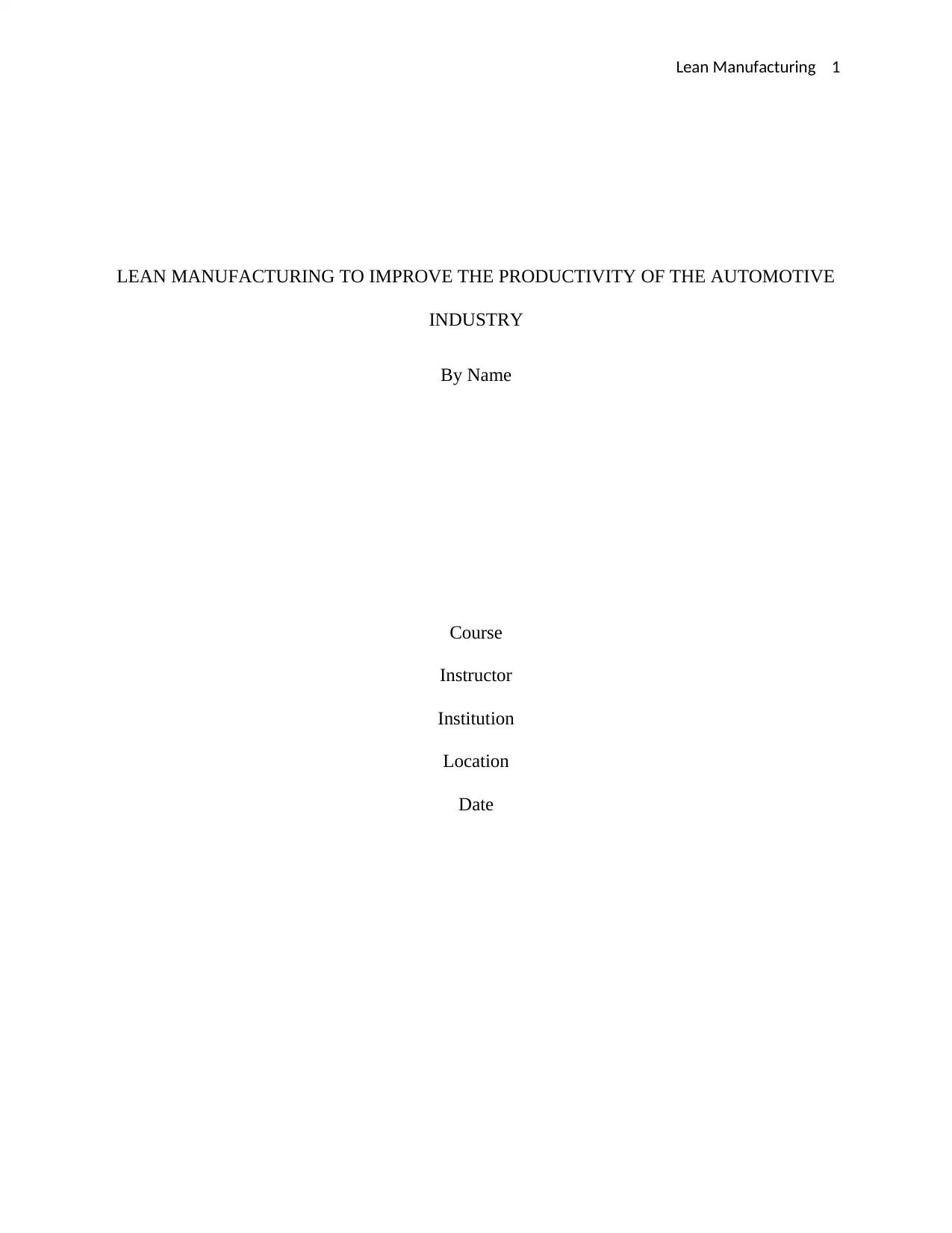
Lean Manufacturing 1
LEAN MANUFACTURING TO IMPROVE THE PRODUCTIVITY OF THE AUTOMOTIVE
INDUSTRY
By Name
Course
Instructor
Institution
Location
Date
LEAN MANUFACTURING TO IMPROVE THE PRODUCTIVITY OF THE AUTOMOTIVE
INDUSTRY
By Name
Course
Instructor
Institution
Location
Date
Paraphrase This Document
Need a fresh take? Get an instant paraphrase of this document with our AI Paraphraser
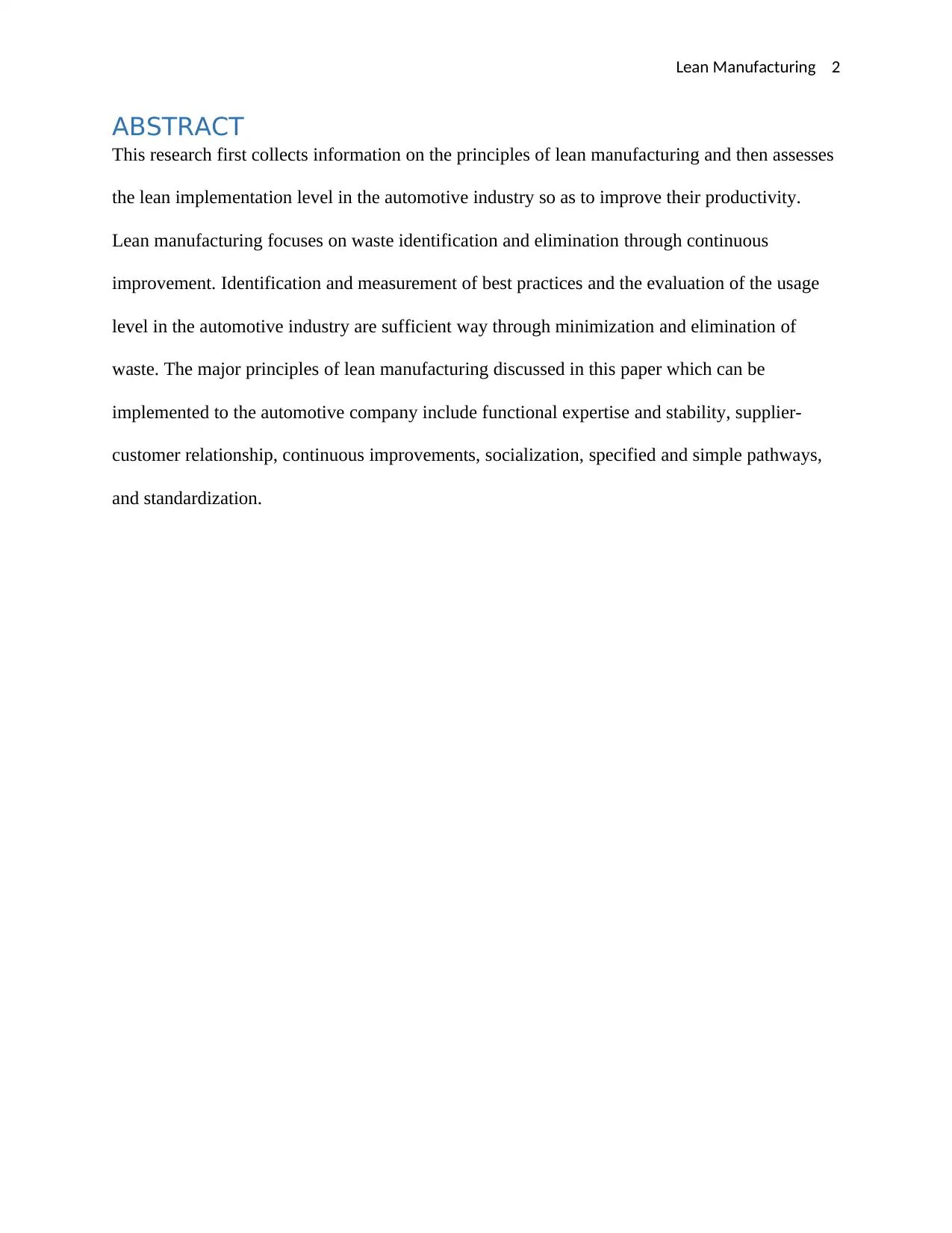
Lean Manufacturing 2
ABSTRACT
This research first collects information on the principles of lean manufacturing and then assesses
the lean implementation level in the automotive industry so as to improve their productivity.
Lean manufacturing focuses on waste identification and elimination through continuous
improvement. Identification and measurement of best practices and the evaluation of the usage
level in the automotive industry are sufficient way through minimization and elimination of
waste. The major principles of lean manufacturing discussed in this paper which can be
implemented to the automotive company include functional expertise and stability, supplier-
customer relationship, continuous improvements, socialization, specified and simple pathways,
and standardization.
ABSTRACT
This research first collects information on the principles of lean manufacturing and then assesses
the lean implementation level in the automotive industry so as to improve their productivity.
Lean manufacturing focuses on waste identification and elimination through continuous
improvement. Identification and measurement of best practices and the evaluation of the usage
level in the automotive industry are sufficient way through minimization and elimination of
waste. The major principles of lean manufacturing discussed in this paper which can be
implemented to the automotive company include functional expertise and stability, supplier-
customer relationship, continuous improvements, socialization, specified and simple pathways,
and standardization.
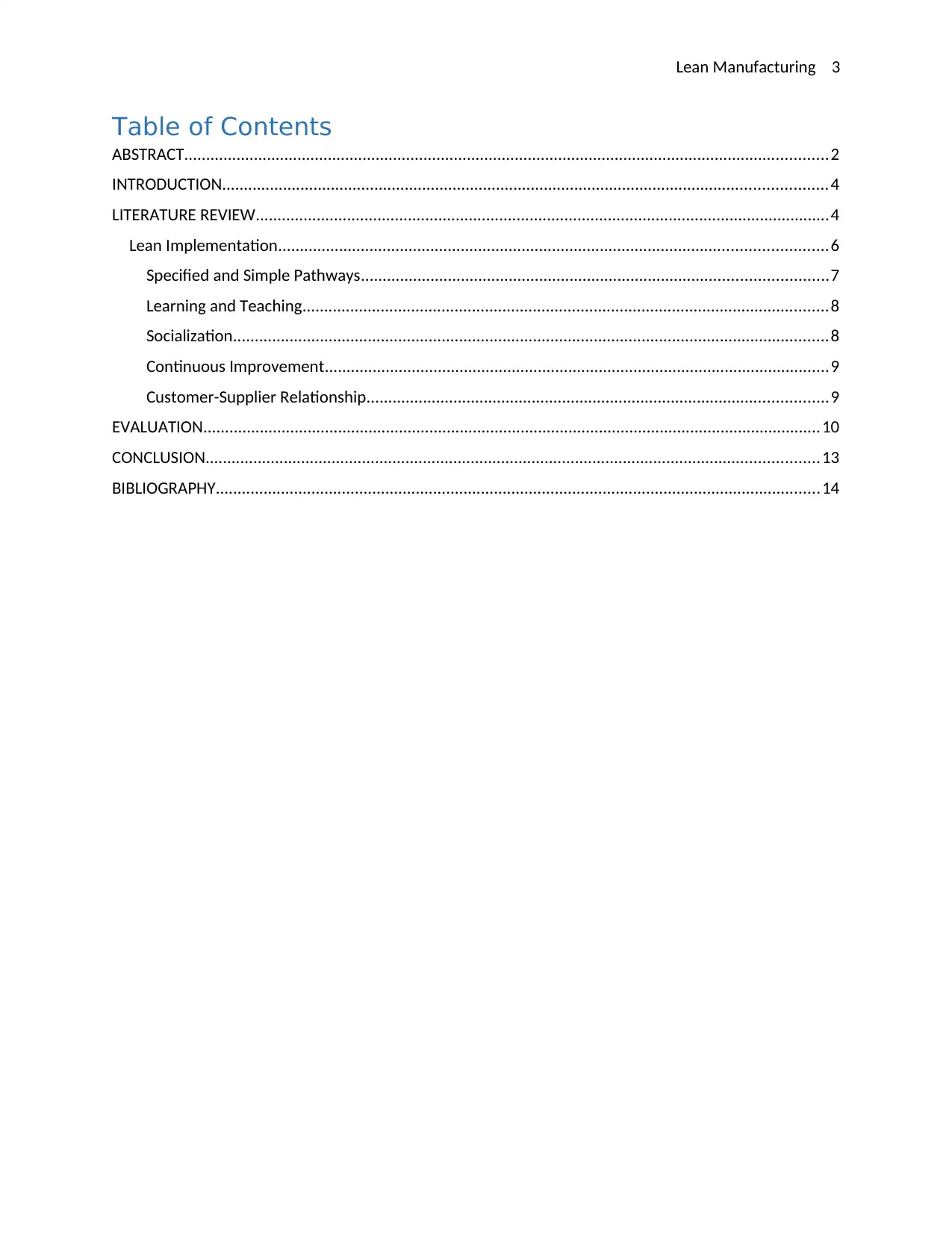
Lean Manufacturing 3
Table of Contents
ABSTRACT....................................................................................................................................................2
INTRODUCTION...........................................................................................................................................4
LITERATURE REVIEW....................................................................................................................................4
Lean Implementation..............................................................................................................................6
Specified and Simple Pathways...........................................................................................................7
Learning and Teaching.........................................................................................................................8
Socialization.........................................................................................................................................8
Continuous Improvement....................................................................................................................9
Customer-Supplier Relationship..........................................................................................................9
EVALUATION..............................................................................................................................................10
CONCLUSION.............................................................................................................................................13
BIBLIOGRAPHY...........................................................................................................................................14
Table of Contents
ABSTRACT....................................................................................................................................................2
INTRODUCTION...........................................................................................................................................4
LITERATURE REVIEW....................................................................................................................................4
Lean Implementation..............................................................................................................................6
Specified and Simple Pathways...........................................................................................................7
Learning and Teaching.........................................................................................................................8
Socialization.........................................................................................................................................8
Continuous Improvement....................................................................................................................9
Customer-Supplier Relationship..........................................................................................................9
EVALUATION..............................................................................................................................................10
CONCLUSION.............................................................................................................................................13
BIBLIOGRAPHY...........................................................................................................................................14
⊘ This is a preview!⊘
Do you want full access?
Subscribe today to unlock all pages.

Trusted by 1+ million students worldwide
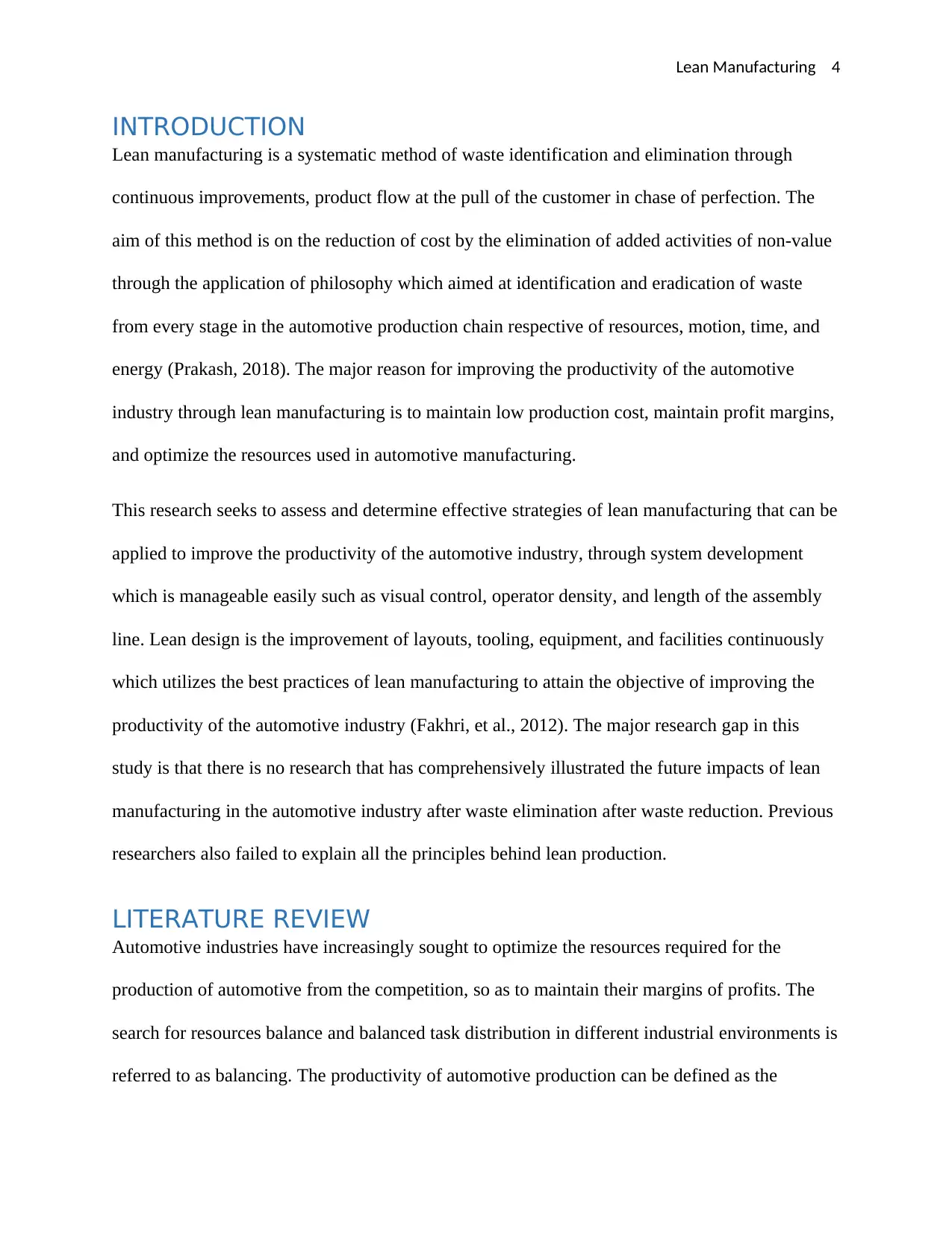
Lean Manufacturing 4
INTRODUCTION
Lean manufacturing is a systematic method of waste identification and elimination through
continuous improvements, product flow at the pull of the customer in chase of perfection. The
aim of this method is on the reduction of cost by the elimination of added activities of non-value
through the application of philosophy which aimed at identification and eradication of waste
from every stage in the automotive production chain respective of resources, motion, time, and
energy (Prakash, 2018). The major reason for improving the productivity of the automotive
industry through lean manufacturing is to maintain low production cost, maintain profit margins,
and optimize the resources used in automotive manufacturing.
This research seeks to assess and determine effective strategies of lean manufacturing that can be
applied to improve the productivity of the automotive industry, through system development
which is manageable easily such as visual control, operator density, and length of the assembly
line. Lean design is the improvement of layouts, tooling, equipment, and facilities continuously
which utilizes the best practices of lean manufacturing to attain the objective of improving the
productivity of the automotive industry (Fakhri, et al., 2012). The major research gap in this
study is that there is no research that has comprehensively illustrated the future impacts of lean
manufacturing in the automotive industry after waste elimination after waste reduction. Previous
researchers also failed to explain all the principles behind lean production.
LITERATURE REVIEW
Automotive industries have increasingly sought to optimize the resources required for the
production of automotive from the competition, so as to maintain their margins of profits. The
search for resources balance and balanced task distribution in different industrial environments is
referred to as balancing. The productivity of automotive production can be defined as the
INTRODUCTION
Lean manufacturing is a systematic method of waste identification and elimination through
continuous improvements, product flow at the pull of the customer in chase of perfection. The
aim of this method is on the reduction of cost by the elimination of added activities of non-value
through the application of philosophy which aimed at identification and eradication of waste
from every stage in the automotive production chain respective of resources, motion, time, and
energy (Prakash, 2018). The major reason for improving the productivity of the automotive
industry through lean manufacturing is to maintain low production cost, maintain profit margins,
and optimize the resources used in automotive manufacturing.
This research seeks to assess and determine effective strategies of lean manufacturing that can be
applied to improve the productivity of the automotive industry, through system development
which is manageable easily such as visual control, operator density, and length of the assembly
line. Lean design is the improvement of layouts, tooling, equipment, and facilities continuously
which utilizes the best practices of lean manufacturing to attain the objective of improving the
productivity of the automotive industry (Fakhri, et al., 2012). The major research gap in this
study is that there is no research that has comprehensively illustrated the future impacts of lean
manufacturing in the automotive industry after waste elimination after waste reduction. Previous
researchers also failed to explain all the principles behind lean production.
LITERATURE REVIEW
Automotive industries have increasingly sought to optimize the resources required for the
production of automotive from the competition, so as to maintain their margins of profits. The
search for resources balance and balanced task distribution in different industrial environments is
referred to as balancing. The productivity of automotive production can be defined as the
Paraphrase This Document
Need a fresh take? Get an instant paraphrase of this document with our AI Paraphraser
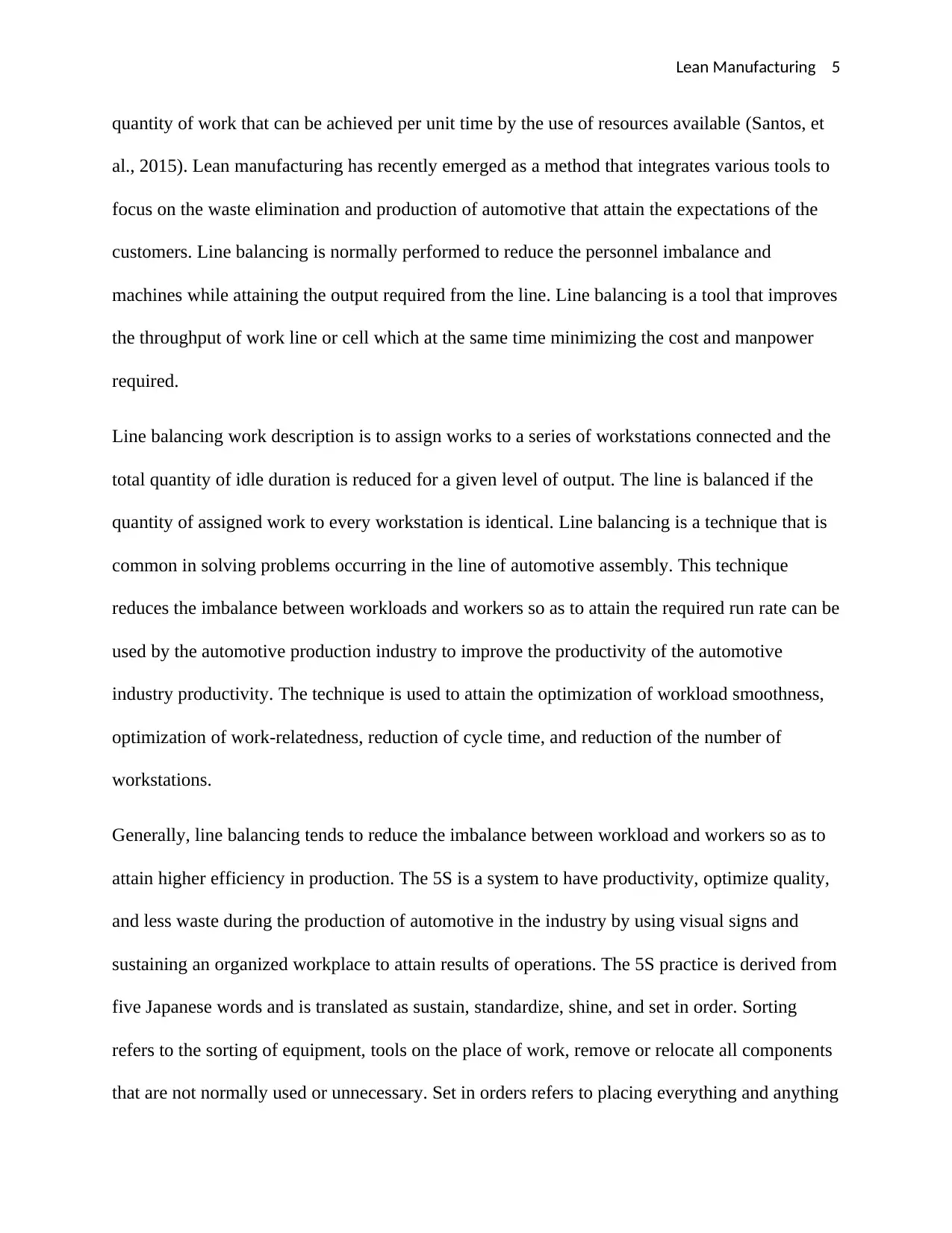
Lean Manufacturing 5
quantity of work that can be achieved per unit time by the use of resources available (Santos, et
al., 2015). Lean manufacturing has recently emerged as a method that integrates various tools to
focus on the waste elimination and production of automotive that attain the expectations of the
customers. Line balancing is normally performed to reduce the personnel imbalance and
machines while attaining the output required from the line. Line balancing is a tool that improves
the throughput of work line or cell which at the same time minimizing the cost and manpower
required.
Line balancing work description is to assign works to a series of workstations connected and the
total quantity of idle duration is reduced for a given level of output. The line is balanced if the
quantity of assigned work to every workstation is identical. Line balancing is a technique that is
common in solving problems occurring in the line of automotive assembly. This technique
reduces the imbalance between workloads and workers so as to attain the required run rate can be
used by the automotive production industry to improve the productivity of the automotive
industry productivity. The technique is used to attain the optimization of workload smoothness,
optimization of work-relatedness, reduction of cycle time, and reduction of the number of
workstations.
Generally, line balancing tends to reduce the imbalance between workload and workers so as to
attain higher efficiency in production. The 5S is a system to have productivity, optimize quality,
and less waste during the production of automotive in the industry by using visual signs and
sustaining an organized workplace to attain results of operations. The 5S practice is derived from
five Japanese words and is translated as sustain, standardize, shine, and set in order. Sorting
refers to the sorting of equipment, tools on the place of work, remove or relocate all components
that are not normally used or unnecessary. Set in orders refers to placing everything and anything
quantity of work that can be achieved per unit time by the use of resources available (Santos, et
al., 2015). Lean manufacturing has recently emerged as a method that integrates various tools to
focus on the waste elimination and production of automotive that attain the expectations of the
customers. Line balancing is normally performed to reduce the personnel imbalance and
machines while attaining the output required from the line. Line balancing is a tool that improves
the throughput of work line or cell which at the same time minimizing the cost and manpower
required.
Line balancing work description is to assign works to a series of workstations connected and the
total quantity of idle duration is reduced for a given level of output. The line is balanced if the
quantity of assigned work to every workstation is identical. Line balancing is a technique that is
common in solving problems occurring in the line of automotive assembly. This technique
reduces the imbalance between workloads and workers so as to attain the required run rate can be
used by the automotive production industry to improve the productivity of the automotive
industry productivity. The technique is used to attain the optimization of workload smoothness,
optimization of work-relatedness, reduction of cycle time, and reduction of the number of
workstations.
Generally, line balancing tends to reduce the imbalance between workload and workers so as to
attain higher efficiency in production. The 5S is a system to have productivity, optimize quality,
and less waste during the production of automotive in the industry by using visual signs and
sustaining an organized workplace to attain results of operations. The 5S practice is derived from
five Japanese words and is translated as sustain, standardize, shine, and set in order. Sorting
refers to the sorting of equipment, tools on the place of work, remove or relocate all components
that are not normally used or unnecessary. Set in orders refers to placing everything and anything
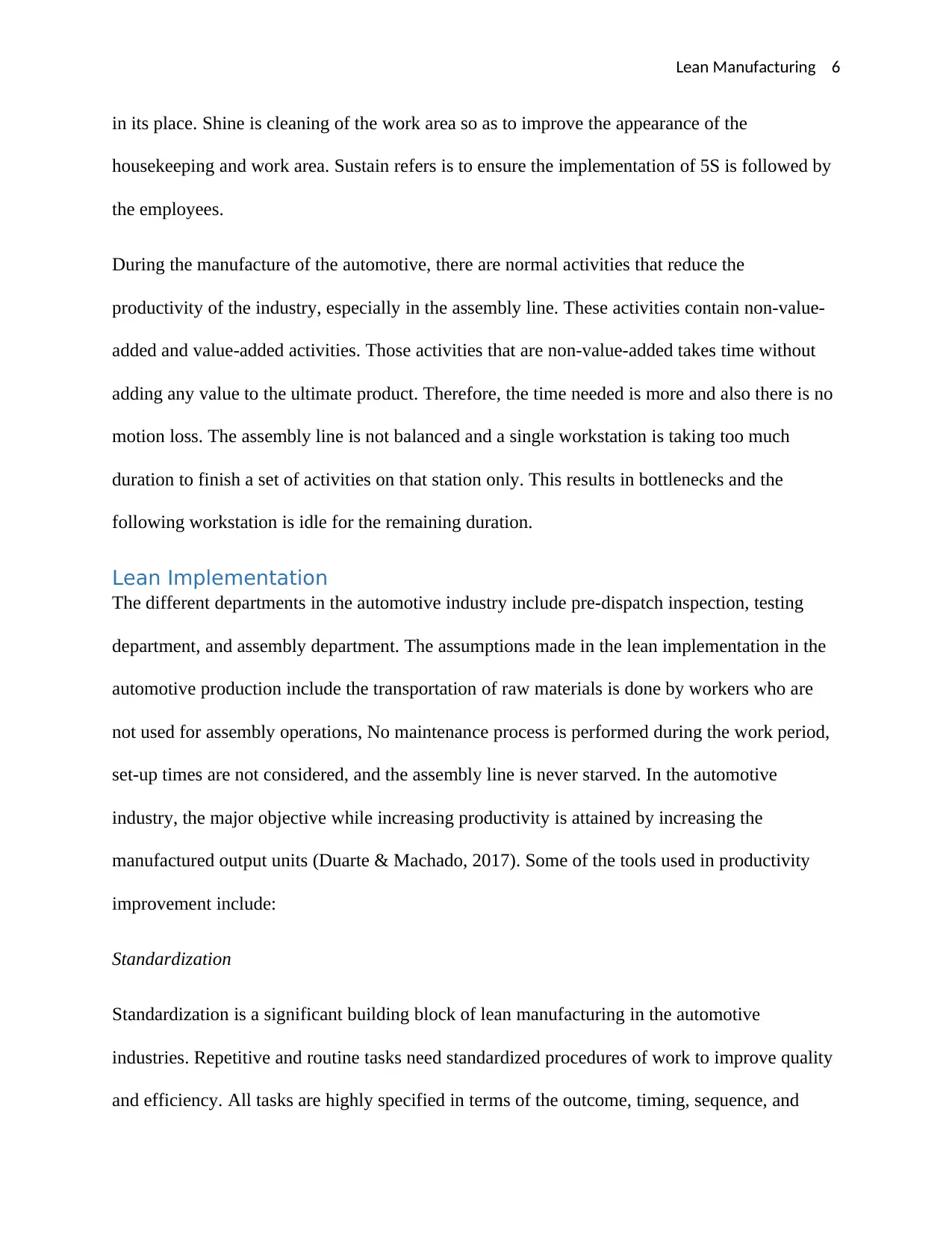
Lean Manufacturing 6
in its place. Shine is cleaning of the work area so as to improve the appearance of the
housekeeping and work area. Sustain refers is to ensure the implementation of 5S is followed by
the employees.
During the manufacture of the automotive, there are normal activities that reduce the
productivity of the industry, especially in the assembly line. These activities contain non-value-
added and value-added activities. Those activities that are non-value-added takes time without
adding any value to the ultimate product. Therefore, the time needed is more and also there is no
motion loss. The assembly line is not balanced and a single workstation is taking too much
duration to finish a set of activities on that station only. This results in bottlenecks and the
following workstation is idle for the remaining duration.
Lean Implementation
The different departments in the automotive industry include pre-dispatch inspection, testing
department, and assembly department. The assumptions made in the lean implementation in the
automotive production include the transportation of raw materials is done by workers who are
not used for assembly operations, No maintenance process is performed during the work period,
set-up times are not considered, and the assembly line is never starved. In the automotive
industry, the major objective while increasing productivity is attained by increasing the
manufactured output units (Duarte & Machado, 2017). Some of the tools used in productivity
improvement include:
Standardization
Standardization is a significant building block of lean manufacturing in the automotive
industries. Repetitive and routine tasks need standardized procedures of work to improve quality
and efficiency. All tasks are highly specified in terms of the outcome, timing, sequence, and
in its place. Shine is cleaning of the work area so as to improve the appearance of the
housekeeping and work area. Sustain refers is to ensure the implementation of 5S is followed by
the employees.
During the manufacture of the automotive, there are normal activities that reduce the
productivity of the industry, especially in the assembly line. These activities contain non-value-
added and value-added activities. Those activities that are non-value-added takes time without
adding any value to the ultimate product. Therefore, the time needed is more and also there is no
motion loss. The assembly line is not balanced and a single workstation is taking too much
duration to finish a set of activities on that station only. This results in bottlenecks and the
following workstation is idle for the remaining duration.
Lean Implementation
The different departments in the automotive industry include pre-dispatch inspection, testing
department, and assembly department. The assumptions made in the lean implementation in the
automotive production include the transportation of raw materials is done by workers who are
not used for assembly operations, No maintenance process is performed during the work period,
set-up times are not considered, and the assembly line is never starved. In the automotive
industry, the major objective while increasing productivity is attained by increasing the
manufactured output units (Duarte & Machado, 2017). Some of the tools used in productivity
improvement include:
Standardization
Standardization is a significant building block of lean manufacturing in the automotive
industries. Repetitive and routine tasks need standardized procedures of work to improve quality
and efficiency. All tasks are highly specified in terms of the outcome, timing, sequence, and
⊘ This is a preview!⊘
Do you want full access?
Subscribe today to unlock all pages.

Trusted by 1+ million students worldwide
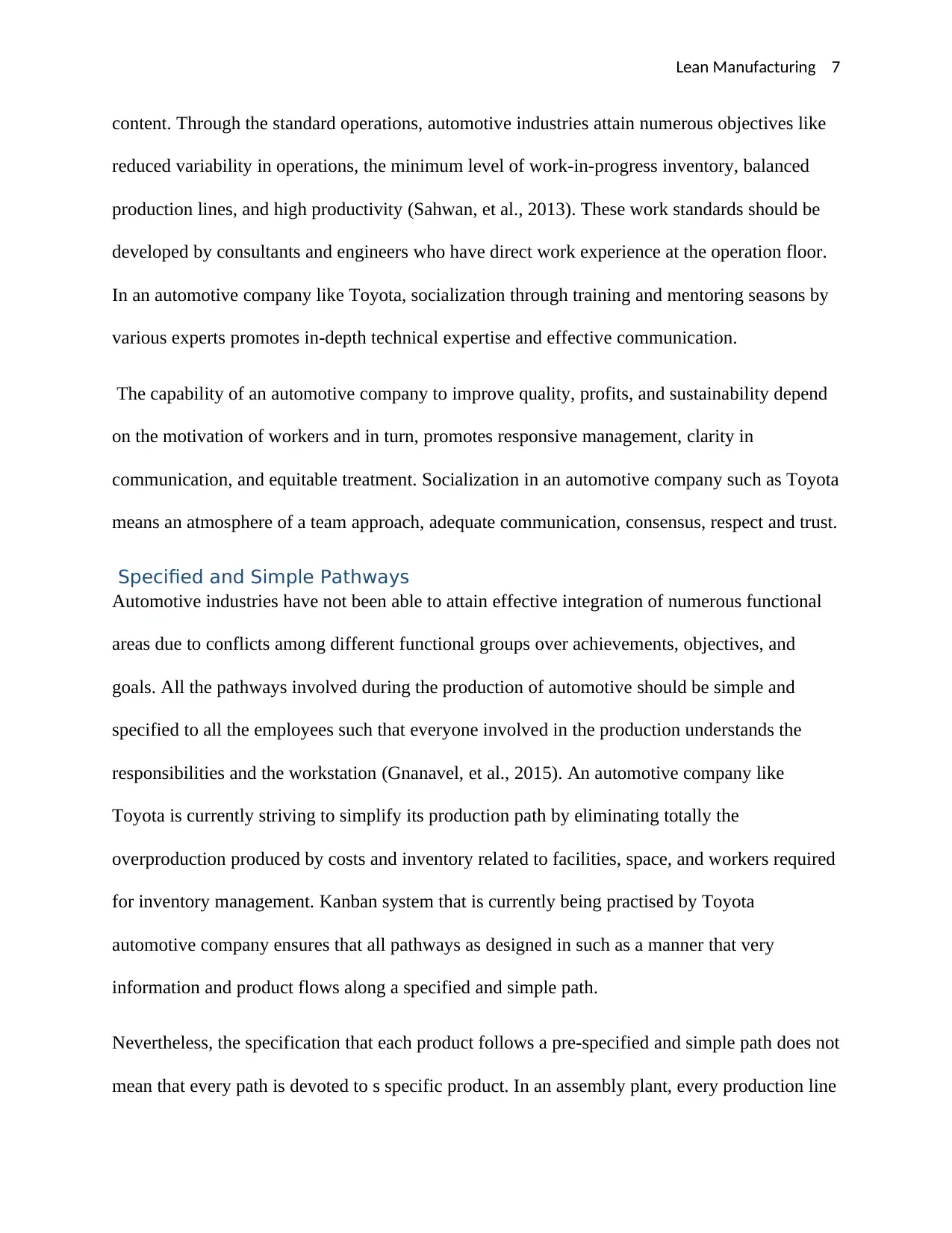
Lean Manufacturing 7
content. Through the standard operations, automotive industries attain numerous objectives like
reduced variability in operations, the minimum level of work-in-progress inventory, balanced
production lines, and high productivity (Sahwan, et al., 2013). These work standards should be
developed by consultants and engineers who have direct work experience at the operation floor.
In an automotive company like Toyota, socialization through training and mentoring seasons by
various experts promotes in-depth technical expertise and effective communication.
The capability of an automotive company to improve quality, profits, and sustainability depend
on the motivation of workers and in turn, promotes responsive management, clarity in
communication, and equitable treatment. Socialization in an automotive company such as Toyota
means an atmosphere of a team approach, adequate communication, consensus, respect and trust.
Specified and Simple Pathways
Automotive industries have not been able to attain effective integration of numerous functional
areas due to conflicts among different functional groups over achievements, objectives, and
goals. All the pathways involved during the production of automotive should be simple and
specified to all the employees such that everyone involved in the production understands the
responsibilities and the workstation (Gnanavel, et al., 2015). An automotive company like
Toyota is currently striving to simplify its production path by eliminating totally the
overproduction produced by costs and inventory related to facilities, space, and workers required
for inventory management. Kanban system that is currently being practised by Toyota
automotive company ensures that all pathways as designed in such as a manner that very
information and product flows along a specified and simple path.
Nevertheless, the specification that each product follows a pre-specified and simple path does not
mean that every path is devoted to s specific product. In an assembly plant, every production line
content. Through the standard operations, automotive industries attain numerous objectives like
reduced variability in operations, the minimum level of work-in-progress inventory, balanced
production lines, and high productivity (Sahwan, et al., 2013). These work standards should be
developed by consultants and engineers who have direct work experience at the operation floor.
In an automotive company like Toyota, socialization through training and mentoring seasons by
various experts promotes in-depth technical expertise and effective communication.
The capability of an automotive company to improve quality, profits, and sustainability depend
on the motivation of workers and in turn, promotes responsive management, clarity in
communication, and equitable treatment. Socialization in an automotive company such as Toyota
means an atmosphere of a team approach, adequate communication, consensus, respect and trust.
Specified and Simple Pathways
Automotive industries have not been able to attain effective integration of numerous functional
areas due to conflicts among different functional groups over achievements, objectives, and
goals. All the pathways involved during the production of automotive should be simple and
specified to all the employees such that everyone involved in the production understands the
responsibilities and the workstation (Gnanavel, et al., 2015). An automotive company like
Toyota is currently striving to simplify its production path by eliminating totally the
overproduction produced by costs and inventory related to facilities, space, and workers required
for inventory management. Kanban system that is currently being practised by Toyota
automotive company ensures that all pathways as designed in such as a manner that very
information and product flows along a specified and simple path.
Nevertheless, the specification that each product follows a pre-specified and simple path does not
mean that every path is devoted to s specific product. In an assembly plant, every production line
Paraphrase This Document
Need a fresh take? Get an instant paraphrase of this document with our AI Paraphraser
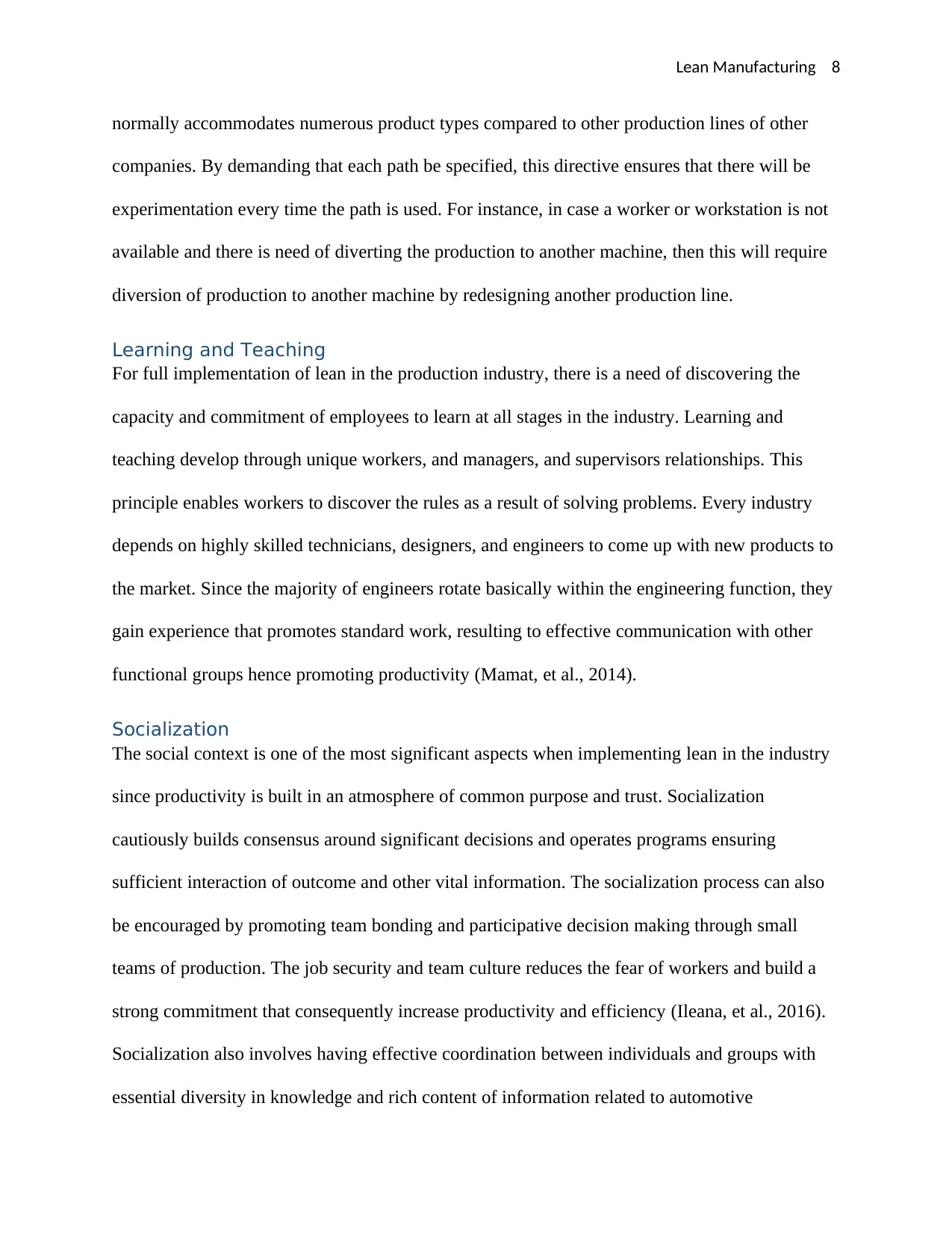
Lean Manufacturing 8
normally accommodates numerous product types compared to other production lines of other
companies. By demanding that each path be specified, this directive ensures that there will be
experimentation every time the path is used. For instance, in case a worker or workstation is not
available and there is need of diverting the production to another machine, then this will require
diversion of production to another machine by redesigning another production line.
Learning and Teaching
For full implementation of lean in the production industry, there is a need of discovering the
capacity and commitment of employees to learn at all stages in the industry. Learning and
teaching develop through unique workers, and managers, and supervisors relationships. This
principle enables workers to discover the rules as a result of solving problems. Every industry
depends on highly skilled technicians, designers, and engineers to come up with new products to
the market. Since the majority of engineers rotate basically within the engineering function, they
gain experience that promotes standard work, resulting to effective communication with other
functional groups hence promoting productivity (Mamat, et al., 2014).
Socialization
The social context is one of the most significant aspects when implementing lean in the industry
since productivity is built in an atmosphere of common purpose and trust. Socialization
cautiously builds consensus around significant decisions and operates programs ensuring
sufficient interaction of outcome and other vital information. The socialization process can also
be encouraged by promoting team bonding and participative decision making through small
teams of production. The job security and team culture reduces the fear of workers and build a
strong commitment that consequently increase productivity and efficiency (Ileana, et al., 2016).
Socialization also involves having effective coordination between individuals and groups with
essential diversity in knowledge and rich content of information related to automotive
normally accommodates numerous product types compared to other production lines of other
companies. By demanding that each path be specified, this directive ensures that there will be
experimentation every time the path is used. For instance, in case a worker or workstation is not
available and there is need of diverting the production to another machine, then this will require
diversion of production to another machine by redesigning another production line.
Learning and Teaching
For full implementation of lean in the production industry, there is a need of discovering the
capacity and commitment of employees to learn at all stages in the industry. Learning and
teaching develop through unique workers, and managers, and supervisors relationships. This
principle enables workers to discover the rules as a result of solving problems. Every industry
depends on highly skilled technicians, designers, and engineers to come up with new products to
the market. Since the majority of engineers rotate basically within the engineering function, they
gain experience that promotes standard work, resulting to effective communication with other
functional groups hence promoting productivity (Mamat, et al., 2014).
Socialization
The social context is one of the most significant aspects when implementing lean in the industry
since productivity is built in an atmosphere of common purpose and trust. Socialization
cautiously builds consensus around significant decisions and operates programs ensuring
sufficient interaction of outcome and other vital information. The socialization process can also
be encouraged by promoting team bonding and participative decision making through small
teams of production. The job security and team culture reduces the fear of workers and build a
strong commitment that consequently increase productivity and efficiency (Ileana, et al., 2016).
Socialization also involves having effective coordination between individuals and groups with
essential diversity in knowledge and rich content of information related to automotive
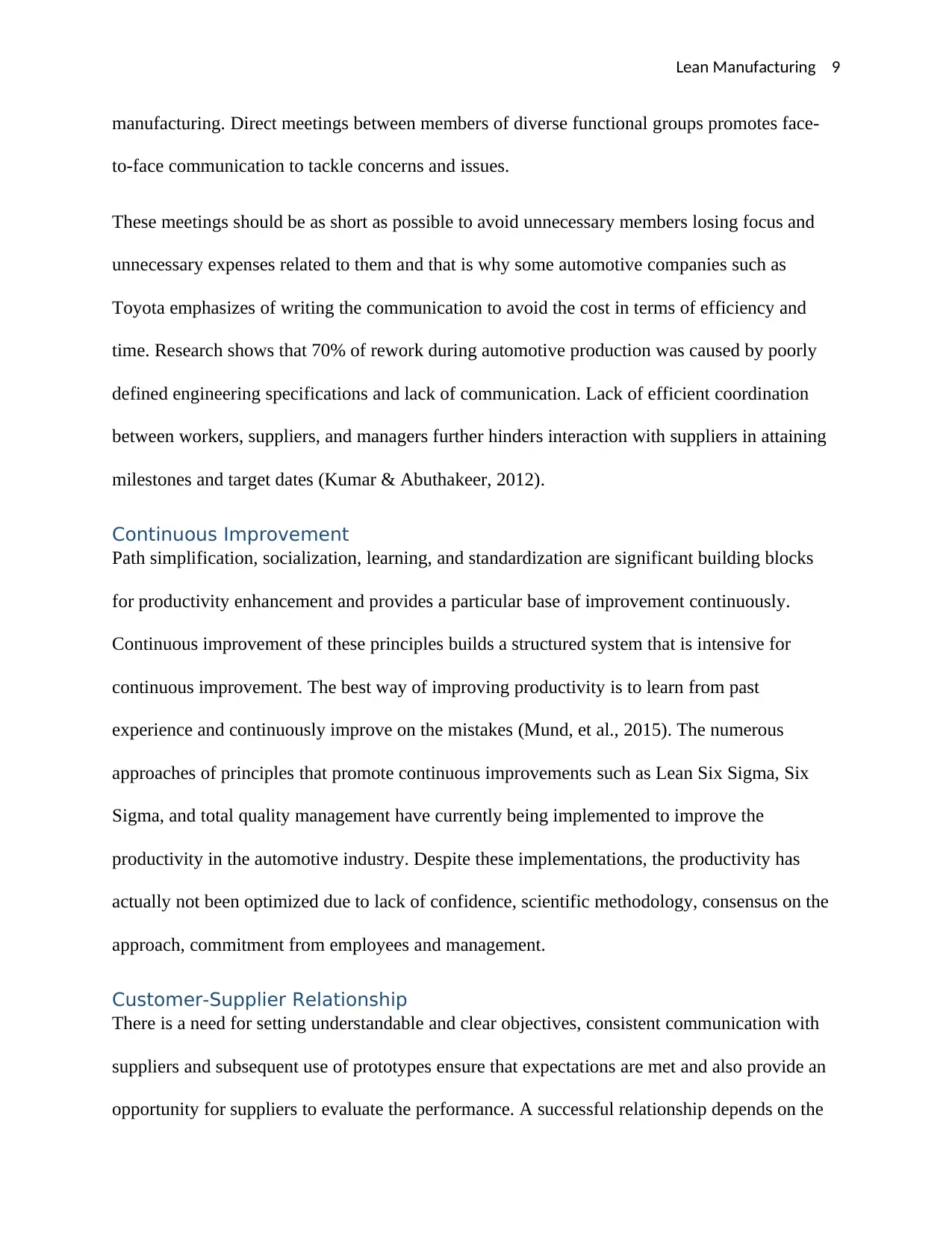
Lean Manufacturing 9
manufacturing. Direct meetings between members of diverse functional groups promotes face-
to-face communication to tackle concerns and issues.
These meetings should be as short as possible to avoid unnecessary members losing focus and
unnecessary expenses related to them and that is why some automotive companies such as
Toyota emphasizes of writing the communication to avoid the cost in terms of efficiency and
time. Research shows that 70% of rework during automotive production was caused by poorly
defined engineering specifications and lack of communication. Lack of efficient coordination
between workers, suppliers, and managers further hinders interaction with suppliers in attaining
milestones and target dates (Kumar & Abuthakeer, 2012).
Continuous Improvement
Path simplification, socialization, learning, and standardization are significant building blocks
for productivity enhancement and provides a particular base of improvement continuously.
Continuous improvement of these principles builds a structured system that is intensive for
continuous improvement. The best way of improving productivity is to learn from past
experience and continuously improve on the mistakes (Mund, et al., 2015). The numerous
approaches of principles that promote continuous improvements such as Lean Six Sigma, Six
Sigma, and total quality management have currently being implemented to improve the
productivity in the automotive industry. Despite these implementations, the productivity has
actually not been optimized due to lack of confidence, scientific methodology, consensus on the
approach, commitment from employees and management.
Customer-Supplier Relationship
There is a need for setting understandable and clear objectives, consistent communication with
suppliers and subsequent use of prototypes ensure that expectations are met and also provide an
opportunity for suppliers to evaluate the performance. A successful relationship depends on the
manufacturing. Direct meetings between members of diverse functional groups promotes face-
to-face communication to tackle concerns and issues.
These meetings should be as short as possible to avoid unnecessary members losing focus and
unnecessary expenses related to them and that is why some automotive companies such as
Toyota emphasizes of writing the communication to avoid the cost in terms of efficiency and
time. Research shows that 70% of rework during automotive production was caused by poorly
defined engineering specifications and lack of communication. Lack of efficient coordination
between workers, suppliers, and managers further hinders interaction with suppliers in attaining
milestones and target dates (Kumar & Abuthakeer, 2012).
Continuous Improvement
Path simplification, socialization, learning, and standardization are significant building blocks
for productivity enhancement and provides a particular base of improvement continuously.
Continuous improvement of these principles builds a structured system that is intensive for
continuous improvement. The best way of improving productivity is to learn from past
experience and continuously improve on the mistakes (Mund, et al., 2015). The numerous
approaches of principles that promote continuous improvements such as Lean Six Sigma, Six
Sigma, and total quality management have currently being implemented to improve the
productivity in the automotive industry. Despite these implementations, the productivity has
actually not been optimized due to lack of confidence, scientific methodology, consensus on the
approach, commitment from employees and management.
Customer-Supplier Relationship
There is a need for setting understandable and clear objectives, consistent communication with
suppliers and subsequent use of prototypes ensure that expectations are met and also provide an
opportunity for suppliers to evaluate the performance. A successful relationship depends on the
⊘ This is a preview!⊘
Do you want full access?
Subscribe today to unlock all pages.

Trusted by 1+ million students worldwide
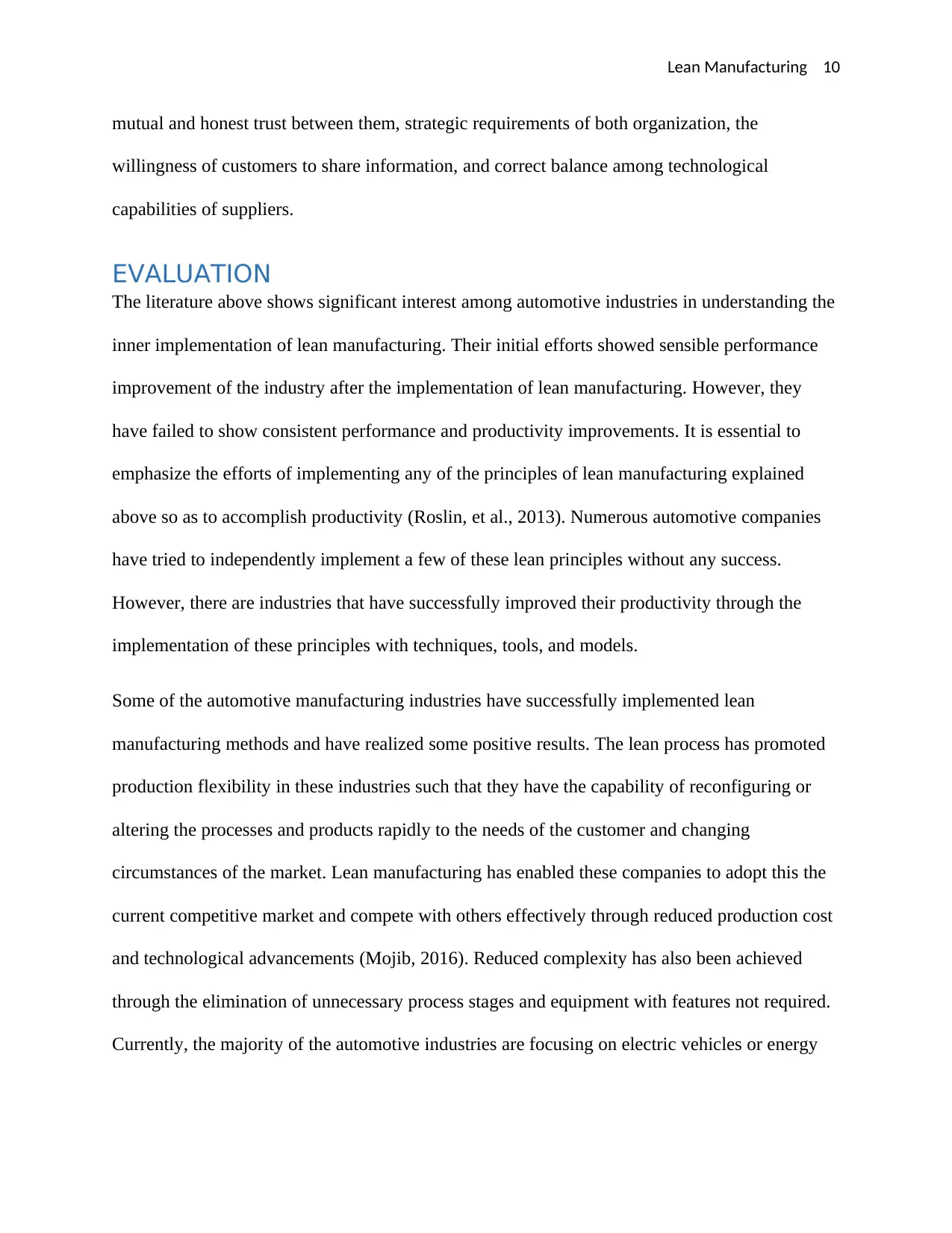
Lean Manufacturing 10
mutual and honest trust between them, strategic requirements of both organization, the
willingness of customers to share information, and correct balance among technological
capabilities of suppliers.
EVALUATION
The literature above shows significant interest among automotive industries in understanding the
inner implementation of lean manufacturing. Their initial efforts showed sensible performance
improvement of the industry after the implementation of lean manufacturing. However, they
have failed to show consistent performance and productivity improvements. It is essential to
emphasize the efforts of implementing any of the principles of lean manufacturing explained
above so as to accomplish productivity (Roslin, et al., 2013). Numerous automotive companies
have tried to independently implement a few of these lean principles without any success.
However, there are industries that have successfully improved their productivity through the
implementation of these principles with techniques, tools, and models.
Some of the automotive manufacturing industries have successfully implemented lean
manufacturing methods and have realized some positive results. The lean process has promoted
production flexibility in these industries such that they have the capability of reconfiguring or
altering the processes and products rapidly to the needs of the customer and changing
circumstances of the market. Lean manufacturing has enabled these companies to adopt this the
current competitive market and compete with others effectively through reduced production cost
and technological advancements (Mojib, 2016). Reduced complexity has also been achieved
through the elimination of unnecessary process stages and equipment with features not required.
Currently, the majority of the automotive industries are focusing on electric vehicles or energy
mutual and honest trust between them, strategic requirements of both organization, the
willingness of customers to share information, and correct balance among technological
capabilities of suppliers.
EVALUATION
The literature above shows significant interest among automotive industries in understanding the
inner implementation of lean manufacturing. Their initial efforts showed sensible performance
improvement of the industry after the implementation of lean manufacturing. However, they
have failed to show consistent performance and productivity improvements. It is essential to
emphasize the efforts of implementing any of the principles of lean manufacturing explained
above so as to accomplish productivity (Roslin, et al., 2013). Numerous automotive companies
have tried to independently implement a few of these lean principles without any success.
However, there are industries that have successfully improved their productivity through the
implementation of these principles with techniques, tools, and models.
Some of the automotive manufacturing industries have successfully implemented lean
manufacturing methods and have realized some positive results. The lean process has promoted
production flexibility in these industries such that they have the capability of reconfiguring or
altering the processes and products rapidly to the needs of the customer and changing
circumstances of the market. Lean manufacturing has enabled these companies to adopt this the
current competitive market and compete with others effectively through reduced production cost
and technological advancements (Mojib, 2016). Reduced complexity has also been achieved
through the elimination of unnecessary process stages and equipment with features not required.
Currently, the majority of the automotive industries are focusing on electric vehicles or energy
Paraphrase This Document
Need a fresh take? Get an instant paraphrase of this document with our AI Paraphraser
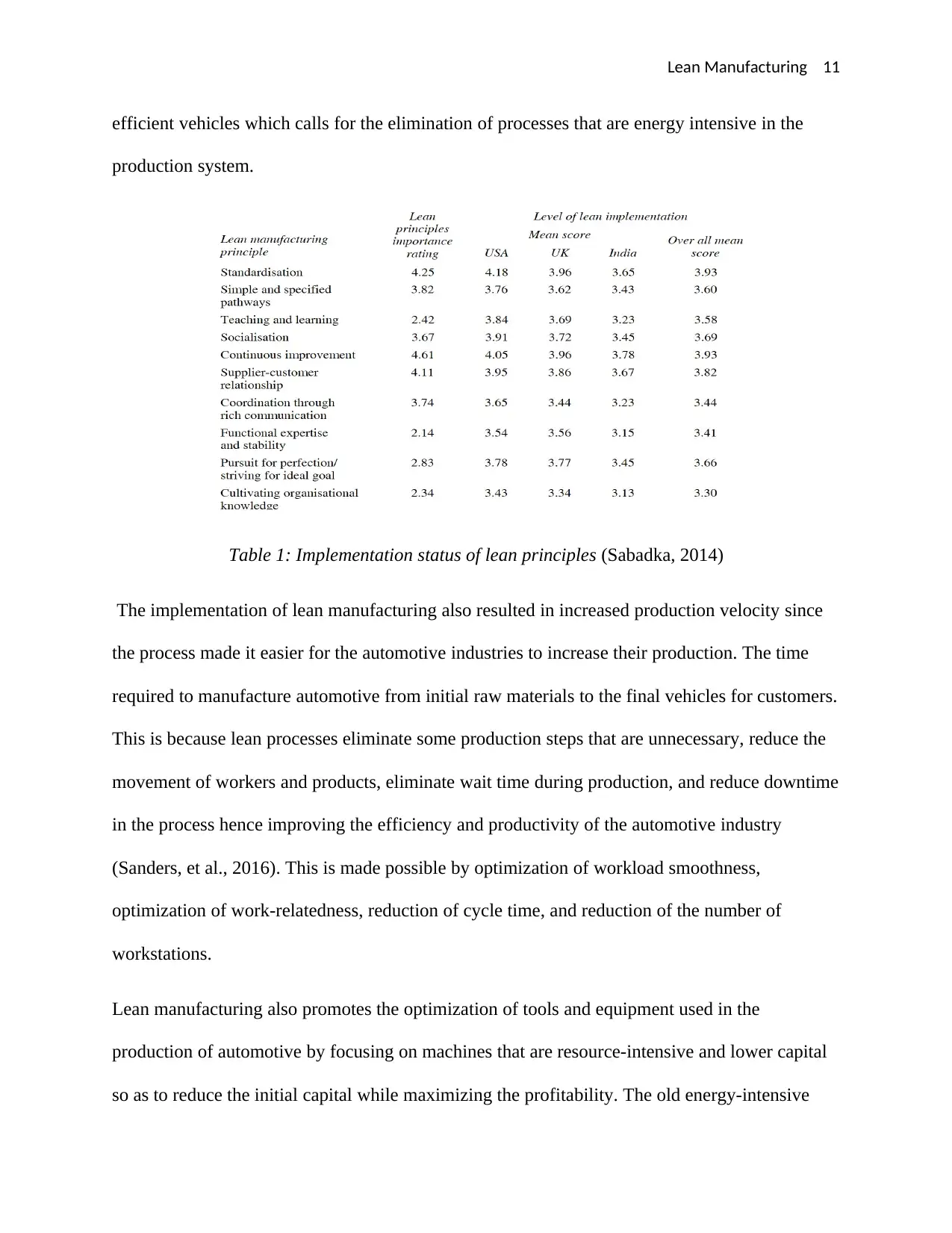
Lean Manufacturing 11
efficient vehicles which calls for the elimination of processes that are energy intensive in the
production system.
Table 1: Implementation status of lean principles (Sabadka, 2014)
The implementation of lean manufacturing also resulted in increased production velocity since
the process made it easier for the automotive industries to increase their production. The time
required to manufacture automotive from initial raw materials to the final vehicles for customers.
This is because lean processes eliminate some production steps that are unnecessary, reduce the
movement of workers and products, eliminate wait time during production, and reduce downtime
in the process hence improving the efficiency and productivity of the automotive industry
(Sanders, et al., 2016). This is made possible by optimization of workload smoothness,
optimization of work-relatedness, reduction of cycle time, and reduction of the number of
workstations.
Lean manufacturing also promotes the optimization of tools and equipment used in the
production of automotive by focusing on machines that are resource-intensive and lower capital
so as to reduce the initial capital while maximizing the profitability. The old energy-intensive
efficient vehicles which calls for the elimination of processes that are energy intensive in the
production system.
Table 1: Implementation status of lean principles (Sabadka, 2014)
The implementation of lean manufacturing also resulted in increased production velocity since
the process made it easier for the automotive industries to increase their production. The time
required to manufacture automotive from initial raw materials to the final vehicles for customers.
This is because lean processes eliminate some production steps that are unnecessary, reduce the
movement of workers and products, eliminate wait time during production, and reduce downtime
in the process hence improving the efficiency and productivity of the automotive industry
(Sanders, et al., 2016). This is made possible by optimization of workload smoothness,
optimization of work-relatedness, reduction of cycle time, and reduction of the number of
workstations.
Lean manufacturing also promotes the optimization of tools and equipment used in the
production of automotive by focusing on machines that are resource-intensive and lower capital
so as to reduce the initial capital while maximizing the profitability. The old energy-intensive
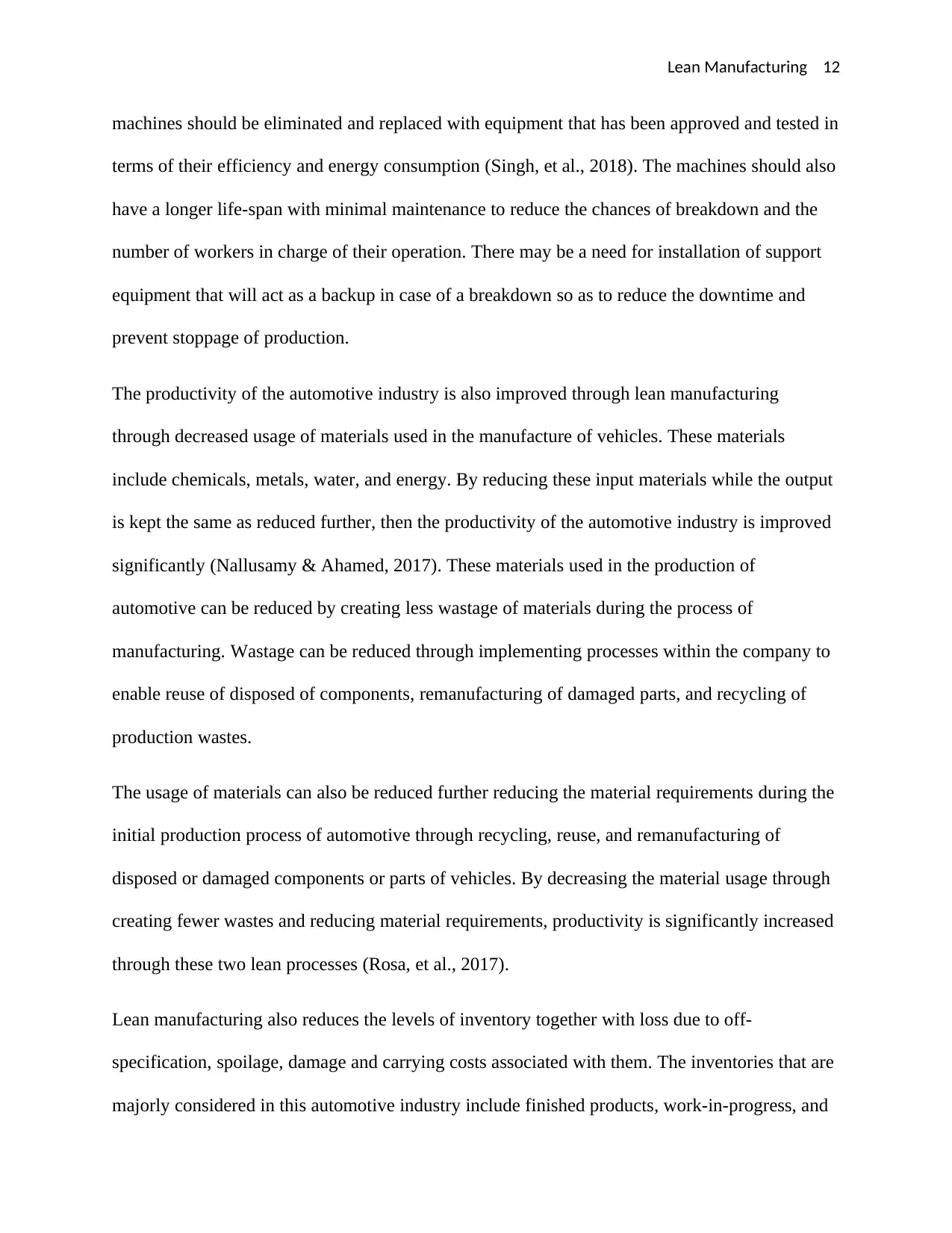
Lean Manufacturing 12
machines should be eliminated and replaced with equipment that has been approved and tested in
terms of their efficiency and energy consumption (Singh, et al., 2018). The machines should also
have a longer life-span with minimal maintenance to reduce the chances of breakdown and the
number of workers in charge of their operation. There may be a need for installation of support
equipment that will act as a backup in case of a breakdown so as to reduce the downtime and
prevent stoppage of production.
The productivity of the automotive industry is also improved through lean manufacturing
through decreased usage of materials used in the manufacture of vehicles. These materials
include chemicals, metals, water, and energy. By reducing these input materials while the output
is kept the same as reduced further, then the productivity of the automotive industry is improved
significantly (Nallusamy & Ahamed, 2017). These materials used in the production of
automotive can be reduced by creating less wastage of materials during the process of
manufacturing. Wastage can be reduced through implementing processes within the company to
enable reuse of disposed of components, remanufacturing of damaged parts, and recycling of
production wastes.
The usage of materials can also be reduced further reducing the material requirements during the
initial production process of automotive through recycling, reuse, and remanufacturing of
disposed or damaged components or parts of vehicles. By decreasing the material usage through
creating fewer wastes and reducing material requirements, productivity is significantly increased
through these two lean processes (Rosa, et al., 2017).
Lean manufacturing also reduces the levels of inventory together with loss due to off-
specification, spoilage, damage and carrying costs associated with them. The inventories that are
majorly considered in this automotive industry include finished products, work-in-progress, and
machines should be eliminated and replaced with equipment that has been approved and tested in
terms of their efficiency and energy consumption (Singh, et al., 2018). The machines should also
have a longer life-span with minimal maintenance to reduce the chances of breakdown and the
number of workers in charge of their operation. There may be a need for installation of support
equipment that will act as a backup in case of a breakdown so as to reduce the downtime and
prevent stoppage of production.
The productivity of the automotive industry is also improved through lean manufacturing
through decreased usage of materials used in the manufacture of vehicles. These materials
include chemicals, metals, water, and energy. By reducing these input materials while the output
is kept the same as reduced further, then the productivity of the automotive industry is improved
significantly (Nallusamy & Ahamed, 2017). These materials used in the production of
automotive can be reduced by creating less wastage of materials during the process of
manufacturing. Wastage can be reduced through implementing processes within the company to
enable reuse of disposed of components, remanufacturing of damaged parts, and recycling of
production wastes.
The usage of materials can also be reduced further reducing the material requirements during the
initial production process of automotive through recycling, reuse, and remanufacturing of
disposed or damaged components or parts of vehicles. By decreasing the material usage through
creating fewer wastes and reducing material requirements, productivity is significantly increased
through these two lean processes (Rosa, et al., 2017).
Lean manufacturing also reduces the levels of inventory together with loss due to off-
specification, spoilage, damage and carrying costs associated with them. The inventories that are
majorly considered in this automotive industry include finished products, work-in-progress, and
⊘ This is a preview!⊘
Do you want full access?
Subscribe today to unlock all pages.

Trusted by 1+ million students worldwide
1 out of 15
Related Documents
Your All-in-One AI-Powered Toolkit for Academic Success.
+13062052269
info@desklib.com
Available 24*7 on WhatsApp / Email
![[object Object]](/_next/static/media/star-bottom.7253800d.svg)
Unlock your academic potential
Copyright © 2020–2025 A2Z Services. All Rights Reserved. Developed and managed by ZUCOL.




